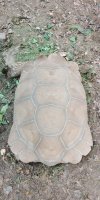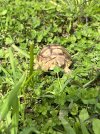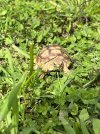Nellie Rose
Member
Hello everybody! It's been a long time. I posted one thread like 3 years ago and never came back, but this is my first new tortoise in 10 years.
The tortoise belonged to a kid who went to college. But the parents were adamant they did not want it.
So the poor baby ended up abandoned, and sent to a shelter.
So the baby needed a new home. I kept tabs on her for about a week, before contacting to see if I could adopt her.
I have wanted a sulcata my whole life, and have randomly considered it, but this past year I have been doing some real research into them, and I feel really prepared to take her in.
I've got a 4×2×2 enclosure to start. It's not ideal I know, but she will be moved into a 300 gal stock eventually. Currently she is around 4 inches, we've guessed around a year old.
For the summer I have a 4×8 garden bed to keep her in, until she gets bigger. Then I will build a big fenced in area, I want to build her a little watering hole, and I'll get a heated shed for winter. She'll probably share the area with my birds, so the ducks will have access to the pond. Itll be well filtered, I've built them before. Ideally she'll still be able to go outside in the winter, but be able to retreat into her 90F+ house to warm up, and then get locked in at night. Of course she'll have a basking spot during winter as well to keep her nice and toasty. But this is all just ideas for the future, I need to do more research into keeping giant tortoises in colder climates.
In the short term I'm making this thread so I can be sure I'm doing all this right, and getting her a good start.
I'll post more later. I don't have much time now to post pictures and all of the info I need to. I don't have her yet, I'll be picking her up after pictures of my temporary enclosure are approved.
Right now I'm getting the enclosure set up. If my information is correct babies need much higher humidity as adults, so it is a closed chamber. I'm using a mix of substrates, forest floor, sand, organic soil. With a nice clay soaking dish, and a humid hide.
I'd like to say that yes I understand that Sulcatas are cows with shells, and need a huge space to thrive, and I'm prepared to provide that. She'll have a heated shed in the winter, 60×30 pen in the summer once she is big enough. I fully intend on exceeding the minimum space requirements as she grows, I have 1 acre to take advantage of so whatever I can fence off and make escape proof and predator proof she can have. While forums are overwhelmingly positive in general, I just want to skip over the "are you sure this is a good idea" posts and jump right to the advice and knowledge that can help me and the little one get off to the right start.
But I have never had a sulcata before, or any kind of African tortoise, so advice is very much appreciated!!!
I'll post pictures soon, of her and of her first enclosure.
I'll also need to post an update on my Hermann’s Tortoise, Herrmann soon. He is doing great, and his personality is finally starting to level out.
Ever since finding her I've been looking at other rescues and there's so many Sulcatas that have been abandoned and surrendered!
It's unbelievable how many there are, and so sad. Just because they get them when they're little and then get rid of them when they grow up.
Mine is an unusual situation as I've ended up with a young one, but if all goes well with her perhaps I will get more once I have a SIZABLE outdoor pen and heated house. That is a long time away though and I don't want to even think about that now.
But anyway! That's everything. Post more info and some pictures soon. I just wanted to get the story that started this out.
The tortoise belonged to a kid who went to college. But the parents were adamant they did not want it.
So the poor baby ended up abandoned, and sent to a shelter.
So the baby needed a new home. I kept tabs on her for about a week, before contacting to see if I could adopt her.
I have wanted a sulcata my whole life, and have randomly considered it, but this past year I have been doing some real research into them, and I feel really prepared to take her in.
I've got a 4×2×2 enclosure to start. It's not ideal I know, but she will be moved into a 300 gal stock eventually. Currently she is around 4 inches, we've guessed around a year old.
For the summer I have a 4×8 garden bed to keep her in, until she gets bigger. Then I will build a big fenced in area, I want to build her a little watering hole, and I'll get a heated shed for winter. She'll probably share the area with my birds, so the ducks will have access to the pond. Itll be well filtered, I've built them before. Ideally she'll still be able to go outside in the winter, but be able to retreat into her 90F+ house to warm up, and then get locked in at night. Of course she'll have a basking spot during winter as well to keep her nice and toasty. But this is all just ideas for the future, I need to do more research into keeping giant tortoises in colder climates.
In the short term I'm making this thread so I can be sure I'm doing all this right, and getting her a good start.
I'll post more later. I don't have much time now to post pictures and all of the info I need to. I don't have her yet, I'll be picking her up after pictures of my temporary enclosure are approved.
Right now I'm getting the enclosure set up. If my information is correct babies need much higher humidity as adults, so it is a closed chamber. I'm using a mix of substrates, forest floor, sand, organic soil. With a nice clay soaking dish, and a humid hide.
I'd like to say that yes I understand that Sulcatas are cows with shells, and need a huge space to thrive, and I'm prepared to provide that. She'll have a heated shed in the winter, 60×30 pen in the summer once she is big enough. I fully intend on exceeding the minimum space requirements as she grows, I have 1 acre to take advantage of so whatever I can fence off and make escape proof and predator proof she can have. While forums are overwhelmingly positive in general, I just want to skip over the "are you sure this is a good idea" posts and jump right to the advice and knowledge that can help me and the little one get off to the right start.
But I have never had a sulcata before, or any kind of African tortoise, so advice is very much appreciated!!!
I'll post pictures soon, of her and of her first enclosure.
I'll also need to post an update on my Hermann’s Tortoise, Herrmann soon. He is doing great, and his personality is finally starting to level out.
Ever since finding her I've been looking at other rescues and there's so many Sulcatas that have been abandoned and surrendered!
It's unbelievable how many there are, and so sad. Just because they get them when they're little and then get rid of them when they grow up.
Mine is an unusual situation as I've ended up with a young one, but if all goes well with her perhaps I will get more once I have a SIZABLE outdoor pen and heated house. That is a long time away though and I don't want to even think about that now.
But anyway! That's everything. Post more info and some pictures soon. I just wanted to get the story that started this out.




